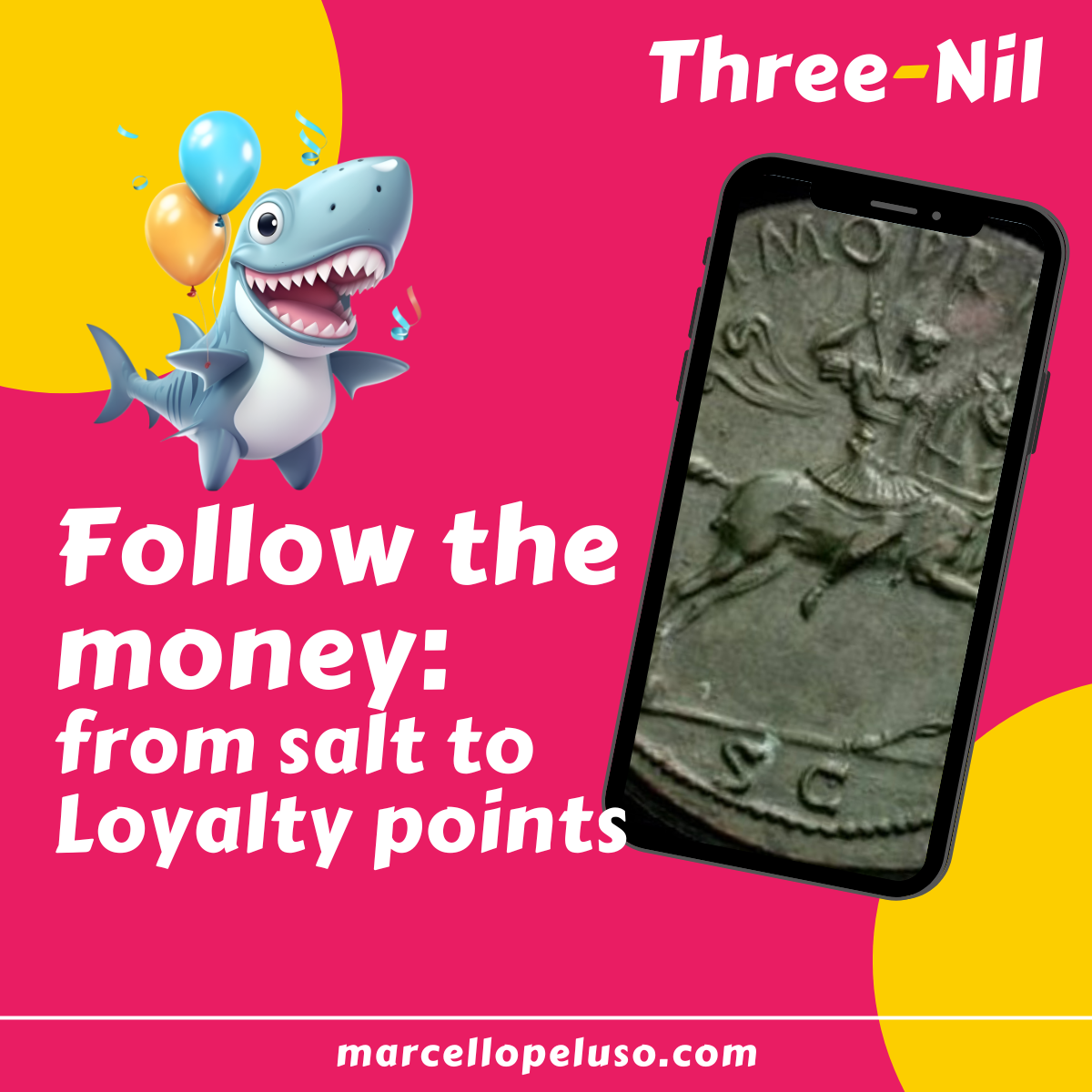
Follow the money: from salt to loyalty points
17/12/2023
Password Hunt: are we truly ready to self-regulate when we use the web?
01/01/2024- X marks the spot
- The differentiating factor of Web 3.0
- Five Types of Web3 Gurus to Steer Clear Of
- Follow the money: from salt to loyalty points
- The future of banks (and our money)
- Password Hunt: are we truly ready to self-regulate when we use the web?
- Let me tell you my secret: I see tokens everywhere
In a distant past, thanks to bartering, we could exchange a chicken for a demijohn of oil. I would give you one of my free-range chickens, and you would give me, more or less, the equivalent in demijohns of the oil you produced in your oil mill. Averaging out the chicken and the oil, we both had eaten half a chicken seasoned with a portion of half a demijohn of oil.
A third wheel

When coins came between you and me (if you missed the discussion on coins, click here), we discovered a way to exchange the chicken for metal, then for paper, and finally for a number: I give you a chicken, and you give me a handful of digital bits that my bank accounts for me. When I log into my bank’s app, I see that the chicken has turned into a number expressed in Euros or Dollars or Pounds.
Between the chicken and my bank account, there is a world of POS, statements, IBAN, Albert – the teller at my bank – and many other things, functions, and people. In short, the bank is an intermediary between you and me.
Today, when talking about decentralized finance, one envisions life with Web 3.0 without banks and the possibility of paying for the sale of my chicken with coins that can be accounted for through multiple encrypted registers distributed on the web (which we call Blockchain) rather than a single register managed by central authorities like my bank.
To perform this operation, however, we need a type of currency that works with new technologies. Easier said than done, but what can we use?
The currencies of the future Excluding for the moment Roman Sesterces and Tesco’s Points that we saw in previous episodes (if you missed them, click here), let’s try to understand how transactions between my chicken and your oil could take place in the future, or how my salary could be paid, or how to collect an invoice for the sale of your oil.
To do this, let’s see what present and future currencies allow us to make transactions (if there are other relevant ones, feel free to mention them in the comments).
Fiat currencies
If for many of us, talking about FIAT brings to mind the Italian model car we used to drive or the one our parents drove, in the world of finance, the term FIAT indicates a national currency issued by a central bank of a national government. They are, in short, the legal currencies within their respective countries.
The Latin term means “let it be done” or “it shall be done” (or… is there a Latin teacher in the room?) and the value is largely tied to trust in the issuing authority. In short, all this unnecessary prelude to say that the Euro, the Dollar, the Pound, the Ruble, etc., are currencies defined as FIAT.
Some of these currencies, like the Dollar or the Euro, enjoy a certain stability. Others, due to the economic weakness of the countries that issue them, geopolitical issues, or various other reasons, can be very weak or have a very fluctuating value.
In history, there have been iconic examples of weak currencies whose value collapsed due to inflation. The German Mark, for example, between 1914 and 1923, lost a billionth of its value (I can’t even imagine what it’s like to lose a billionth of value, roughly it should be 1/1,000,000,000,000).
In the minds of cryptocurrency fans, FIAT currencies are the devil’s dung, a symbol of oppression and the origin of various conspiracies.
Digital currencies
Cryptocurrencies, on the other hand, are virtual currencies that – as we have seen – are based on particular technologies. The most famous cryptocurrency is Bitcoin, then there’s Ether, and another thousand more or less known currencies. You can find them all or almost all here (this piece is not sponsored, but the link is only for informational purposes).
Cryptocurrencies are further divided into:
Cryptocurrencies supported by their own blockchains (like Ethereum and Bitcoin) and therefore “native” to the blockchain, and we call them Coins. Cryptocurrencies that rely on existing blockchains, so not native but developed on third-party blockchains (and we call them tokens). In the minds of critics of the Crypto world, virtual currencies are a speculative madness whose bubble will burst soon. For cryptocurrency fans, however, they are the future.
Stablecoins
In the cryptocurrency universe, Stablecoins are digital currencies anchored to a fiat currency (typical Stablecoins pegged to the value of the dollar) or the value of commodities (like gold) or another cryptocurrency (like Bitcoin).
They are digital currencies anchored to a third-party asset (whether it be money or a commodity) born with the goal of keeping the value stable to fulfill the third fundamental function of money, i.e., serving as a store of value.
But it’s not always the case. In fact, Stablecoins are divided into:
Stablecoins that have a reserve in fiat currency (called collateral). These are the ones we just talked about. If my grandmother created her cryptocurrency (GrandMa Coin) pegged to the value of the dollar (so 1 GrandMa Coin = 1 dollar), my grandmother’s reserve will allow me to convert my GrandMa Coin into a dollar at any time when I need to buy ice cream. Algorithmic Stablecoins (and the name already scares me) are “stable” by name but not always in fact. They are not tied to a fiat currency or any other physical or digital asset, so depending on certain parameters of the algorithm or the speculative moods of the market, the value of the algorithmic Stablecoin can vary… even significantly! In theory, the algorithm intervenes to increase or decrease the value of the cryptocurrency by favoring greater issuance of money (and therefore lowering the value) or favoring a reduction in the issuance of money (and increasing the value of the currency). This is in theory because, in practice, these algorithmic Stablecoins have experienced strong volatility, and many cases of failures and disasters of web3 companies (and not only) started with these cryptocurrencies.
CBDC
Between the world that was and the world that will be, it seems there is also a middle ground that is gaining ground and on which central banks are working: they are the so-called CBDC (just to call them simply, i.e., Central Bank Digital Currency) or virtual currencies issued by central banks with all the criteria of cryptocurrencies.
CBDCs are digital currencies guaranteed by central banks, therefore equipped with the same guarantees as physical currency in circulation in their respective countries.
This particular feature gives CBDCs the missing piece that cryptocurrencies lack, namely the ability to preserve their value, precisely because they are guaranteed by central institutions. Imagine, for example, a Digital Euro (or eEuro or iEuro or whatever they want to call it) issued by the European Central Bank.
But why should a central bank create a virtual currency? Just to compete with “private” cryptocurrencies?
In reality, central bank digital currencies allow overcoming some limitations of traditional FIAT currencies and at the same time take advantage of the benefits of cryptocurrencies. For example, movements between FIAT currencies must first pass through current accounts with longer times and costs compared to the speed, cost-effectiveness, and security ensured by exchanges that take place with digital currencies. And the benefits would not only concern bank customers but the banks themselves in international interbank transactions.
Furthermore, FIAT currencies, unlike digital currencies, cannot be used for a whole range of other digital applications (e.g., Smart Contracts that we won’t discuss today) that, instead, function in the world of blockchains.
On the other hand, CBDCs have a drawback compared to other cryptocurrencies, according to many crypto enthusiasts, namely they do not allow anonymity for owners and transactions. Is this why the digital yuan (the CBDC already issued by the Chinese government) is not gaining much success?
For purists of the decentralized crypto-world, CBDCs are the greatest betrayal of the Web 3.0 religion because the fundamental premise is missing: disintermediation.
The future of my Bank
As we have seen, in the future, the banking system could be bypassed by technologies, although banks themselves might be the first to leverage new technology to optimize their processes and reduce costs.
For us common mortals, a question arises: without an intermediary like the bank, and having to use currencies as a store of value, will we be able to self-regulate?
And do you have more trust in the Dollar, the Digital Dollar, or Bitcoin to receive your salary? Between Bitcoin and the digital Ruble, which one would you choose to collect payment for the invoice of your oil?
